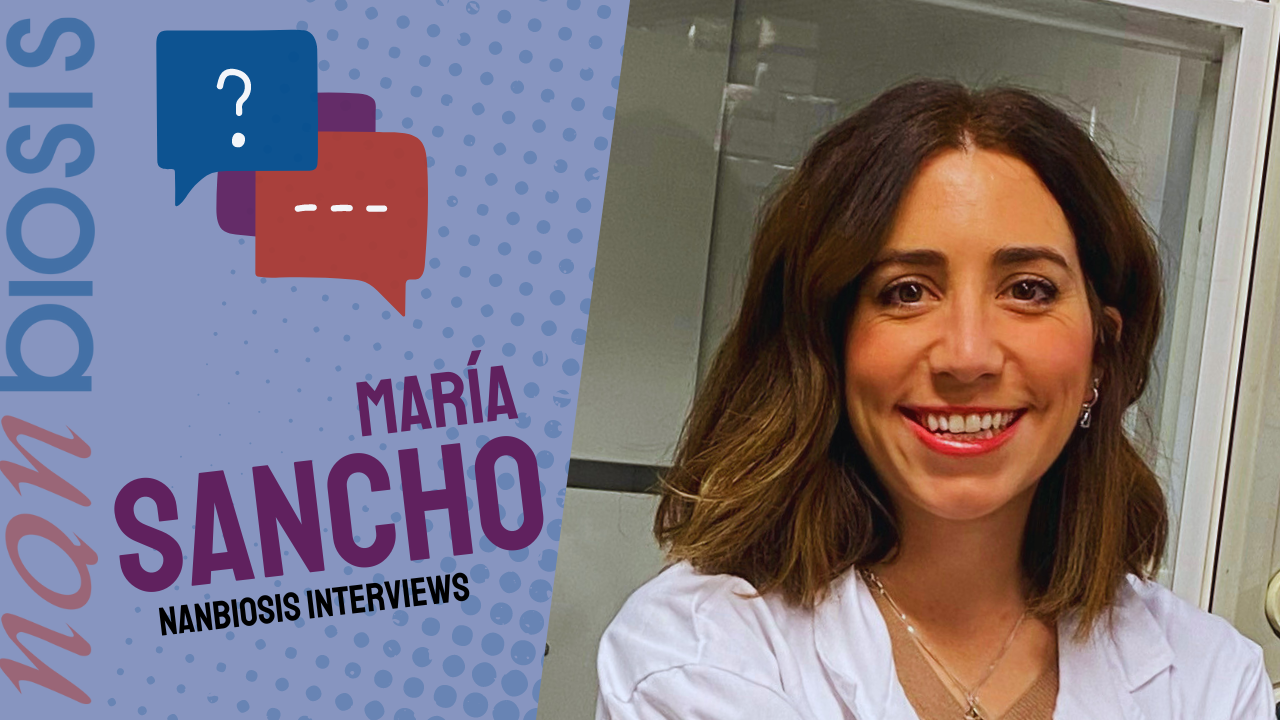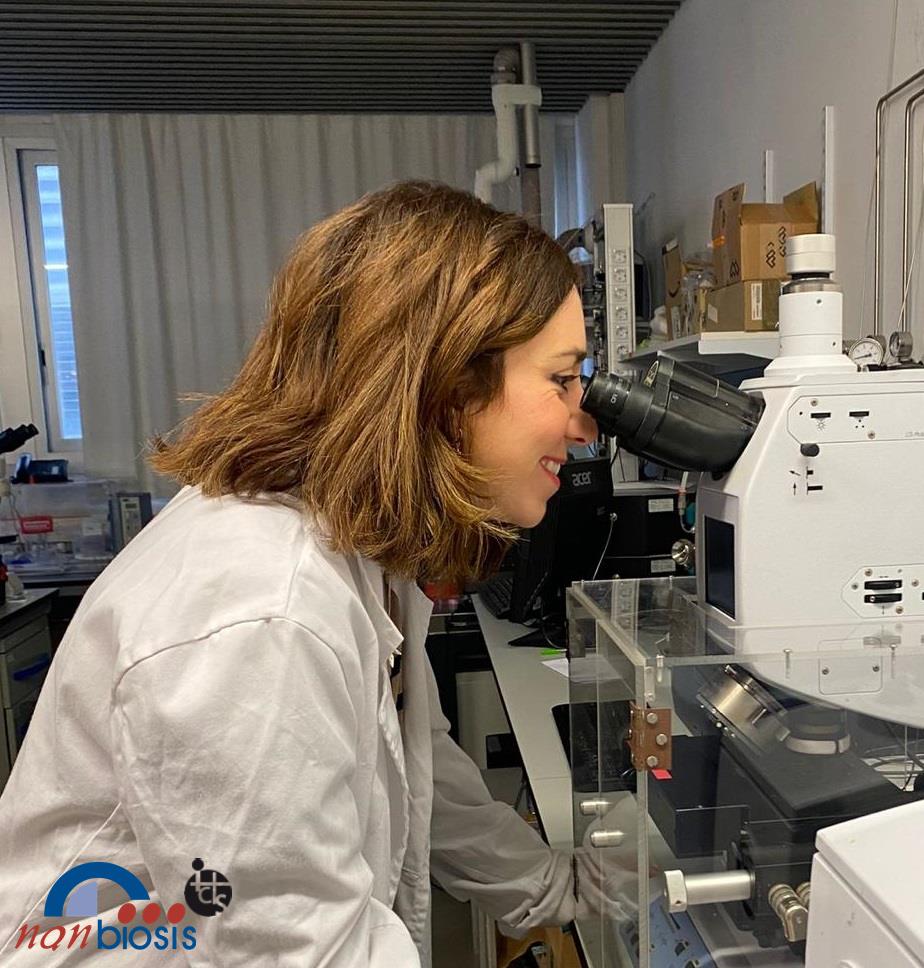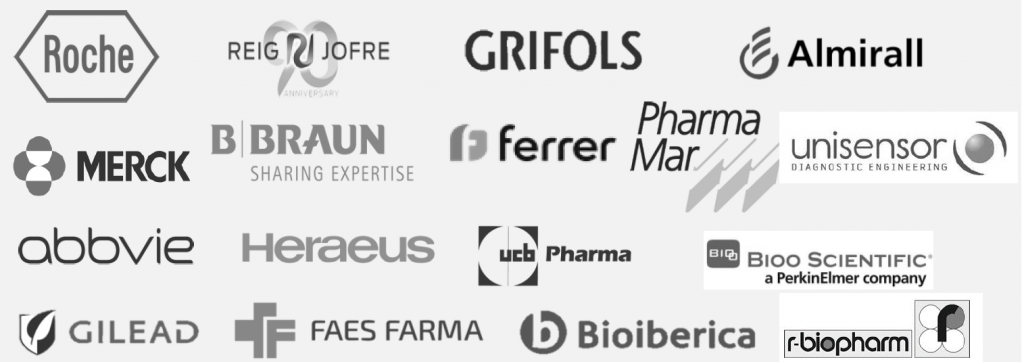
Our expert in nanocarriers talks about her journey from biotechnology to cancer therapy, an example of passion and perseverance in science.
February 2024, I3A/CIBER-BBN, Zaragoza (Spain)
The silence of the meeting room is only broken by the constant purring of the heating system. A large square table made of dark wood fills the entire room almost completely. Its dimensions are too extensive for anyone to reach its center. One may wonder, how many passionate conversations about the next step to take in countless research projects have been witnessed by these four walls?
The door swings open briskly, and a familiar face crosses the threshold with a smile. We have shared lab bench in the past, and María, with her memory honed by years of dedication to her craft, remembers that brief period of our lives surprisingly well. We greet each other warmly. She radiates energy and passion for what she does.
The interview begins.
Hello María, tell us a little about yourself.
“My name is María Sancho, I studied a Bachelor’s Degree in Biotechnology at the University of Zaragoza, just the second generation after its implementation. I did my bachelor’s thesis at the Institute of Nanoscience and Materials of Aragon (INMA), and this contact with nanotechnology made me decide to continue expanding my training in this field and try to dedicate myself to science and research. Then I did the Master’s in Nanomaterials, the ‘NanoMat’, at INMA, as it complemented my biochemistry-oriented training very well with the materials aspect of the Master’s.
After I finished both my bachelor’s and master’s thesis at INMA, I had the opportunity to apply for (and obtain) a prestigious State doctoral scholarship with Jesús Santamaría as Principal Investigator. This allowed me to do my thesis here in Zaragoza, which I defended in December 2020. For the past three years, I have been in Milan, at the Mario Negri Institute of Pharmacological Research, with Luisa De Cola. Her outstanding work focuses mainly on nanomaterials, different from those I worked on during my thesis, allowing me to train in a highly complementary area.”
So, you’re currently doing your postdoc in… Italy?
“No, no. I just returned last October, once again, to Jesús Santamaría’s group, with the goal of establishing here in Zaragoza as a researcher… if possible (laughs).”

“I am fortunate to be able to devote myself to something I am passionate about. Research is something I enjoy every day.”
—Dr. María Sancho, Researcher at Unit 9.
What motivated you to choose a career as a researcher?
“Ever since I was very young, I’ve been an inquisitive, curious, and creative person. I got into research spontaneously, although it’s true that in my family we always talked about scientific research, my father was a teacher and a geologist himself. Over time I’ve realized that science has a vocational component, it requires a lot of dedication, but it excites me. During my high school studies, I was clear about choosing the scientific path. After finishing high school, I pursued a degree in Biotechnology, which had been implemented in Zaragoza just a year before. During my studies, I witnessed the significant advances of the great nanotechnological revolution of recent years. My interest grew only stronger and I decided to do my doctoral studies.
In 2016, I obtained a prestigious and competitive contract for the so-called University Professor Training State program ‘FPU’ from the Ministry of Education. This allowed me to carry out my doctoral thesis at the University of Zaragoza, in a leading and excellent research institute like INMA. So, I could say that I didn’t hesitate to start my career as a scientist. During this period, I was fortunate to have thesis supervisors who transmitted their passion and enthusiasm for research to me. This undoubtedly encouraged me to continue developing my scientific career. Today, I can say that I am fortunate to be able to devote myself to something I am passionate about. Research is something I enjoy every day.
Could you share with us a bit about your area of research and the projects you are currently working on?
“In general terms, my research focuses on developing small containers, which we call nanoparticles, with nanometric dimensions. This means that they are much smaller than human cells. Specifically, my project is based on developing nano-containers capable of directing and transporting drugs and anti-tumor molecules in the body. This way, we load these nanoparticles, which have therapeutic properties, inside vesicles produced by our own body, so that they can kill and act against tumor cells. We hope that these nano-containers with therapeutic properties, once injected into the bloodstream, can reach their target cell and then release the drugs loaded inside them. When we take a painkiller for example, only a small part of the drug acts to relieve that headache. In this project, what we aim for is the possibility of using less therapy and directing it selectively to the tumor. In this way, the maximum possible amount of the supplied active compound reaches the cancer cells. Furthermore, by being encapsulated in these nano-containers and selectively reaching tumor cells, it would ensure avoiding side effects and not affecting other organs.”
What have been the greatest challenges you have faced as a woman in your research field?
“From my experience, to this day, I have not faced challenges attributed to gender. I believe the greatest challenges I have encountered have been common to those of my male colleagues, and are linked to being ‘young researchers’. I associate these challenges with the fact that research is not only an occupation of nearly irrelevant importance in Spain, but also one of great uncertainty, and it is not sufficiently recognized. It requires great dedication, many hours of work, sometimes yielding good results, and other times not. Furthermore, there are few and highly competitive State grants in Spain that allow you to dedicate oneself to research continuously and steadily. As you progress in your research career, you spend more time on bureaucracy, seeking funding and more projects. And the truth is that in the vast majority of cases you won’t get them. This derives in less hours in the lab doing the experiments. I believe there are not enough resources available today.”
Have you ever experienced any type of gender bias or added difficulty in your scientific career? How have you addressed this situation?
“From my experience, up to this day, I have not encountered any additional difficulties compared to men. Nor have I experienced any situations of inequality. However, I do believe that all young researchers, in general, both women and men, face significant challenges in advancing and developing their professional careers. In fact, many of the colleagues I encountered while doing my doctoral thesis have been forced to abandon their scientific careers.”
Could you tell us more about your challenges as a young researcher?
“One of the biggest challenges has been having to go abroad to continue my scientific career. This requires great effort and dedication. Already during my doctoral thesis, I undertook two stays abroad. One of them was for three months at ETH Zurich. The other one lasted for two months at Politecnico di Milano. After completing my doctoral thesis in 2020, I followed the advice of my supervisor to go abroad for at least two more years to continue my postdoctoral career. It was not an easy decision, as I embarked on my journey amid the COVID pandemic, but I had the opportunity to get a job interview with Luisa De Cola, the leader of a globally renowned group.
Although it has been a path full of changes and uncertainty, I don’t feel like I have had to give up anything I wanted in order to pursue my work. However, it’s true that research has taken my time away from other activities. I have probably missed out on doing some things. I have spent two and a half years away from my family and friends in order to continue my education. All this with the goal of returning to Spain as a researcher, which wasn’t even guaranteed. In my case, a few months ago, I managed to secure a postdoctoral grant to develop a research project for four years in Zaragoza, so it has been worth it. Specifically, I have returned to INMA to join the group led by Jesús Santamaría (who was also my thesis supervisor), one of the top scientists in Aragon. He has been involved and supported me throughout my journey as a researcher, even while I was abroad, and he advocated for my return to INMA.”
What advice would you give to young women who are considering pursuing a career in science?
“Firstly, if you’re considering it, I believe that research, like other professions or activities, often reveals its fascination only once you experience it from within. Additionally, it’s a profession that greatly nurtures the mind, fills you with stimuli… and it’s very enriching to formulate a hypothesis and be able to test it in the laboratory. I think it’s something rewarding not only professionally but also personally. In addition, it is a profession that allows you to travel to other countries, get to know other cultures, people who started as colleagues and then became friends. On the other hand, all the teamwork it requires is very satisfying. The individual work you do in the laboratory is later contrasted with others. And yes, it is true that there are bad days when things don’t go your way, but when something works out, it more than makes up for it.”
This is great timing for my next question. Have you had any ‘Eureka’ moments? What do you consider your greatest achievement, or something you feel particularly proud of?
“In 2019, there was a moment when there was a cocktail of people who were working exceptionally well and enthusiastically, of the results we were obtaining, and of the project… All of this allowed us to publish my first paper in Nature, which was highly cited afterwards. This was a really cool moment for me.”
Your very own first-author scientific publication… in Nature. And you were still doing your thesis!
“Yes, I was still working on my thesis. But of course, this achievement is not mine alone. It’s very much intertwined with all the teamwork behind it. It’s a publication that goes hand in hand with projects that Jesús Santamaría had at that time, which allowed us to test all the ideas we had. And of course, thanks to the work of many people, like Santamaría himself, Víctor Sebastián, Pilar Martín, and international collaborators we had in Edinburgh… In short, it was a cocktail that allowed us to do something that didn’t exist in the field. No one had tried vesicles with this type of nanoparticles to make catalysts before! It was a group effort, and very satisfying for all of us.”
If someone in your family, who is not a researcher, asked you about your publication in Nature, how would you explain it to them?
“Well, from a scientific point of view, we managed, for the first time, to encapsulate palladium nanosheets in lung cancer exosomes. These nanosheets are harmless to our body, but they can catalyze a reaction that halts the growth of cancer cells.”
And, as you well said, it was a group effort. What was your contribution to that publication?
“What I did was isolate the vesicles and develop a system to produce the nanosheets inside the vesicles without altering their properties. The thing is, up until that point, when attempts were made to attach these nanosheets to the vesicles, the vesicles ceased to be selective to the cancer they were targeted to. This was because the methods used were too aggressive, causing significant damage to the vesicles. What we did was to develop a very gentle method to achieve high encapsulation efficiency and maintain their ability to selectively reach the tumor. On the other hand, our collaborators in Edinburgh studied all the catalysis and reaction dynamics. So, when we administer a systemic prodrug, it’s harmless throughout the body. But as soon as it reaches the tissue where the cancer is located, this prodrug is catalyzed by the nanosheets into its toxic derivative, acting only on the tumor cells.”
That’s brilliant. Plus, you won’t have the biocompatibility issues seen in other drugs.
“Exactly, because the exosomes you use are naturally produced by the cells themselves. That’s the difference compared to other forms of encapsulation. We only tested it at the in vitro level with cells. But imagine being able to use the patient’s own exosomes to encapsulate the nanosheets. This is a starting point to explore this novel therapy further.”
And indeed, it ended up being published in Nature.
(laughs) “Yes, when such a crazy and bold idea gives you such a good result, it kind of gives you the motivation you need to keep going. And that curiosity we were talking about earlier, which I believe every scientist has, produces a very satisfying and inspiring feeling.”
What changes would you like to see in the scientific world to promote gender equality?
“I believe that calls and projects are being adapted more and more to consider maternity leave periods, etc. This allows individuals of all genders to compete on equal terms. However, it’s true that in higher-level positions, certain roles are still more commonly occupied by men. Although, it’s also true that there are more and more female principal investigators (PIs) leading research groups. I think in the future, we’ll see more and more women leading research groups as PIs.”
How do you think we can encourage more women and girls to participate in science?
“There are many science outreach activities highlighting the role of women in science or showcasing prominent female scientists. Activities like this one, promoted by CIBER-BBN, or by other institutions, are important. In my own Institute (INMA), numerous such activities are conducted, which are part of the objectives included in its Strategic Plan. From the scientific community, we are very interested in promoting interest in science, communicating the importance of scientific advances in different research areas, and conveying the daily work carried out at a prestigious research center. At my institute, we strive to make women and girls visible, inspire them, and promote their participation in science. This includes talks, exhibitions, roundtable discussions, competitions, scavenger hunts, activities in pubs, and a series of scientific talks aimed at schools, as well as in-person workshops.
I don’t think we’re doing it wrong. What is more, I think since COVID people have become more aware of the importance of scientific development. A few years ago, few people knew what a PCR was or the effort behind vaccine development. I believe it is important that society as a whole understands what these careers entail.”
That’s all. Thank you very much, María. It’s been very interesting.
“I’m glad!” (laughs)
This is part of a series of interviews to several female researchers within the context of International Day of Women and Girls in Science 2024 and Woman’s Day 2024. For more interviews, visit our news section here.
Additional information:
The goal of NANBIOSIS is to provide comprehensive and integrated advanced solutions for companies and research institutions in biomedical applications. All of this is done through a single-entry point, involving the design and production of biomaterials, nanomaterials, and their nanoconjugates. This includes their characterization from physical-chemical, functional, toxicological, and biological perspectives (preclinical validation).
In order to access our biomedical Solutions, apply here.
NANBIOSIS has worked with pharmaceutical companies of all sizes in the areas of drug delivery, biomaterials and regenerative medicine. Here are a few of them:









